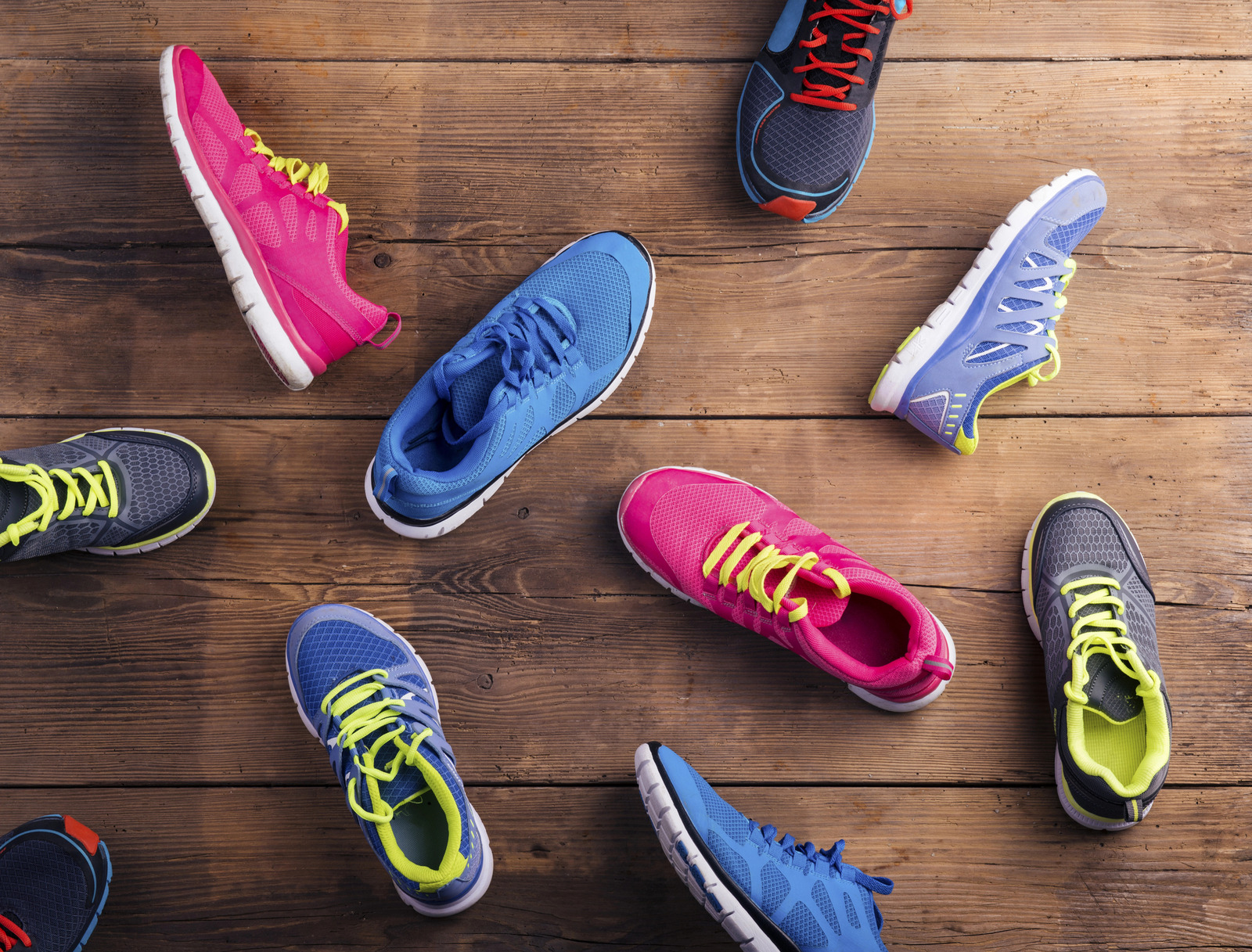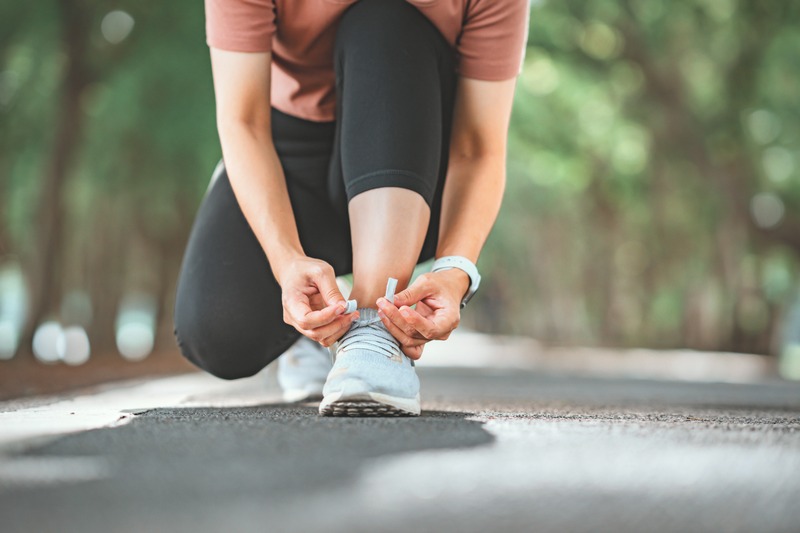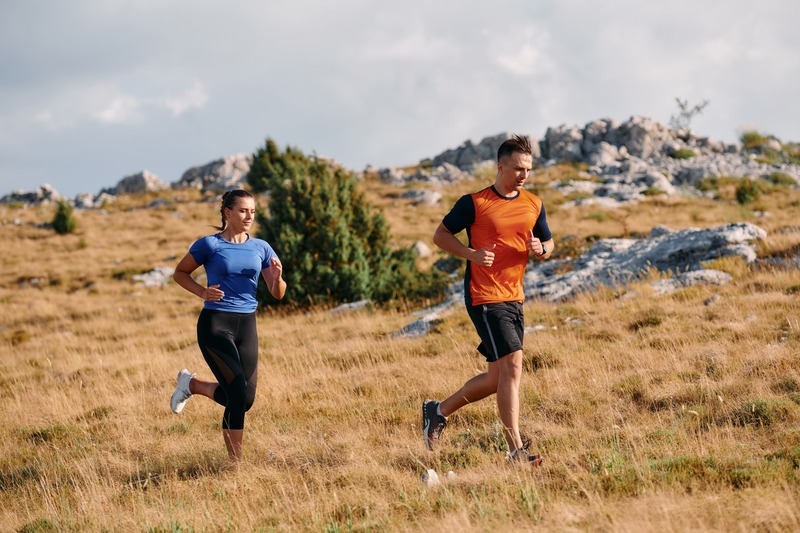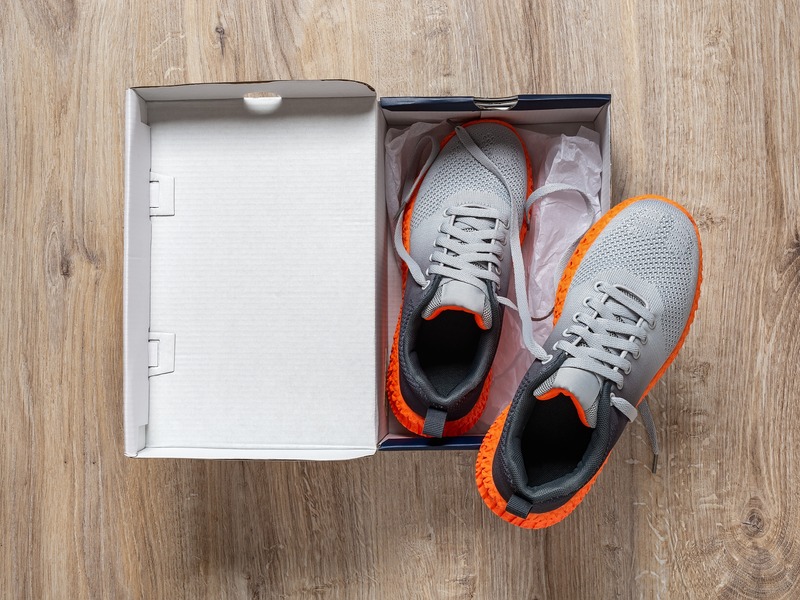The Ultimate Guide to Running Shoes: Find Your Perfect Fit
June 12, 2024

When you buy through links on our site, we may earn an affiliate commission.
Lacing up your sneakers and heading out for a jog around the neighborhood can feel great. But as your runs get longer and your goals grow, those old, worn-out trainers may not cut it anymore. If you've signed up for your first 10k or are getting serious about training for a marathon, it's time to invest in proper running shoes suited for your unique feet and stride.
The right pair makes all the difference in comfort, performance, and keeping injury at bay as the miles add up. Training in unsupportive, improperly fitting shoes is one of the fastest ways to end up sidelined with common running injuries, including runner's knee, shin splints, or other impact-related issues.
To stop that outcome from becoming your fate, we've compiled this ultimate running shoe guide to ensure you find the perfect match. We'll cover all the crucial aspects that go into making the correct choice, including analyzing your foot type, your running style, how you intend to use the running shoes, and how you want them to feel on your feet.
So, without any further delay, let's get right to work and help you choose the best running shoes for you.
Table of Contents
Start By Getting to Know Your Feet
There's no point choosing running shoes that are wrong for your feet. Thus, the process starts with you understanding your unique feet and how they behave when you run to give you a better idea of what you need from your running shoes.
This includes analyzing your arch type, gait pattern, and exact foot dimensions.
Find Your Arch Type
Your arch – low, medium, or high – dramatically impacts the support and cushioning needs of your feet. The good news is that it's something you can fairly easily discover on your own at home. Known as the "Wet Foot Test," here's a quick and simple way to determine which arch type your feet have.
- Fill a shallow pan with a thin layer of water
- Wet the soles of your bare feet
- Step onto a blank sheet of heavy paper or blank cardboard, making full foot contact
- Step off and examine the wet imprint shape
Low arches will leave a near-complete imprint, while high arches have a wide band through the middle, showing little midfoot contact. Just remember, no foot is identical, so it's crucial to repeat this test for both feet, as, chances are, there will be a slight variation. You might even need an insole made for one foot in extreme variations.
If you have very low or high arches, you'll likely look for shoes with extra cushioning and support features. By contrast, medium arches give you more options regarding your shoe choice.
Gait Analysis
If you've ever bought "proper" running shoes, you've probably heard of gait analysis. Most reputable running shoe stores have a gait analysis treadmill set up to determine how you run before choosing the most appropriate shoe.
However, you can set up a similar gait analysis at home with the help of a partner or friend (or a tripod). All you need to do is record yourself running and analyze the footage to understand your pronation tendencies.
Pronation refers to the natural inward roll of your foot when it strikes the ground. Overpronation is when the foot rolls too far inward, while underpronation (or supination) is insufficient inward roll.
The amount of pronation needed for healthy shock absorption is highly individual. Significantly over- or underpronating usually indicates that shoes with more stability and support features are needed.
Here is how you can perform a gait analysis at home:
1. Setup
- Find a flat, firm surface outdoors to record your run. Concrete or asphalt works well.
- Have your friend hold a smartphone to record or set up a tripod and run directly in front of it multiple times.
2. Recording
- Record 5-10-second clips of you running towards, away from, and side-on to the camera. Use the slow-motion function on at least one video from each angle of your recordings to help you analyze your foot strike more easily.
- Capture different speeds – easy jog, tempo run, and sprint.
3. Review
- Watch back videos in slow motion and pause at the moment of foot strike.
- Look for the extent of inward foot roll on impact.
- Compare angles of foot position across speeds.
You're an overpronator if you see yourself rolling inwards excessively as your foot strikes the ground and pushes off. If your foot comes inwards at roughly 15%, your gait is more typical or "neutral" with optimal distribution when landing. Lastly, if you struggle to perceive any inward rolling motion, you are an underpronator (supination).
In the case of supination, there's a high correlation to people with high arches. So, if your Wet Foot Test suggests high arches, your gait analysis may confirm your initial findings.
Shoe Size
Finally, accurately measuring the length and width of both feet is necessary for a good running shoe fit. Feet sizes can differ, so always use the larger foot's measurements when choosing shoe size. Here's how:
- Trace the outline of your foot on paper.
- Measure from the back of the heel to the longest toe.
- Compare to some brand size charts, and go up in size if you find yourself between lengths.
- Repeat for both feet and assess the width at your foot's midpoint.
Another top tip is to find your best-fitting shoes around the house (they don't have to be running shoes). Look for the little size label within the shoes (often stitched into the tongue or a sticker on the insole) and check the European (EU) size. EU sizes move in much smaller increments (your measurement will likely number somewhere in the 40s), and it can make it easier to match shoe sizes across different brands.
Types of Running Shoes: How to Choose the Right Running Shoes for Me
With your foot traits assessed, it's time to delve into the key categories and features to consider when choosing a running shoe. Each aspect will help you narrow down the list of shoes representing a perfect match for your unique needs.
Cushioning
Regarding cushioning, running shoes fall on a spectrum – from ultra-plush to nearly barefoot.
At the max-cushioned end, shoes like the Hoka Bondi feature thick foam midsoles over 35mm in the heel and forefoot. This extreme cushioning works wonders for heavier runners or those logging high weekly mileage. The soft platform dampens impact to save your joints with minimal effort.
However, the thick cushioning does come with a weight penalty. These aren't shoes for setting new personal records in races or workouts. They are for logging daily miles on your easy runs.
On the opposite end, minimalist running shoes offer barely-there cushioning under 10mm. Popular models like the Nike Free and Merrell Vapor Glove offer just enough protection to dull harsh impact while enabling barefoot mechanics. These shoes only suit experienced runners with neutral gaits running over short distances. Any excessive use is likely to lead to injury.
Most runners thrive with a moderate cushioning level of 25-35mm in the heel and 15-25mm in the front. Versatile neutral trainers like the Saucony Ride provide responsive cushioning for daily miles without being too squishy or flat.
As for cushioning technology, midsoles once depended almost entirely on EVA foam. But new foams like Adidas Lightstrike Pro, Nike ZoomX, and New Balance FuelCell offer extra "pop" and energy return with less weight. Meanwhile, Gel pads in Asics shoes provide targeted shock absorption.
Stability vs. Neutral Running Shoes
Understanding the difference between stability and neutral running shoes will be crucial to making the right choice. Stability and neutrality refer to the way running shoes are constructed to control (or not control) pronation (the inward foot rolling upon landing talked about earlier).
This is where you'll rely heavily on your gait analysis to select the correct type of running shoe.
Neutral Running Shoes
Neutral shoes offer balanced cushioning without any pronation-correction features. They allow your foot its natural range of motion and are preferred by efficient midfoot strikers. While there are many popular neutral running shoes, the most well-known examples include the Brooks Ghost and Nike Pegasus.
Stability Running Shoes
Stability shoes integrate structural elements like firmer medial posts and increased torsional rigidity (side-to-side movement) to gently guide excessive inward roll back to the center with each step. This prevents the foot from collapsing inward too far, evenly distributing impact up the kinetic chain. Again, there are dozens of makes and models to choose from, but popular choices include the Asics GT 2000 and the New Balance 860.
For runners who severely overpronate well past the ankle, motion-control shoes maximize stability. Featuring rigid medial posts and guide rail technology, motion control models like the Brooks Addiction hyper-focus on locking down excess pronation. However, this extreme correction feels rigid underfoot and heavy on the foot when running.
Again, you'll need to look at your gait to gauge how much correction or stability you need. If you only slightly overpronate, a neutral shoe might do the trick. Conversely, stability shoes are the best running shoes for overpronation if you heavily roll inward on your footstrike.
Heel-to-Toe Drop
Ever wonder why some runners land more towards the front of their foot while others strike with an obvious heel plant? Mostly, that's just part of natural variations in running biomechanics. But the heel-to-toe drop of their shoes may also be playing its part.
Heel-to-toe drop refers to the height difference between the back and front of the shoe, measured in millimeters. For example, a 10mm drop shoe will sit 10mm taller on the heel than the forefoot. This gradient impacts where your foot naturally contacts the ground with each step.
Traditional high-drop shoes around 12mm guide runners into a heel-first strike. This initially feels natural to some – protecting ankles and lowering calf engagement. However, persisting long-term with a hard heel strike can cause excessive impact up the chain.
As shoes lower towards the 4-8mm range, the smoother gradient encourages more balanced footfalls connecting the midfoot, then gently rolling to push off from the toes. Shoes like the Saucony Kinvara promote this style.
Finally, zero-drop running shoes offer uniform height from heel to toe to closely mimic barefoot running. This strong connection strengthens feet and lower legs over time while enhancing running economy.
There is no universally "best" heel drop. It's a highly personal choice. Lower-drop shoes place stress on the lower leg and ankle, whereas higher-drop shoes shift stress to the knees and hips. Generally speaking, a high-drop shoe makes the most sense for your daily mileage if you're naturally a heel-striker. However, a moderate drop of 8mm or so should be a sound choice if you have a natural gait and are well-suited to a neutral shoe.
But it can be even more nuanced than that. For example, running in higher-drop shoes increases cadence and takes the strain off the lower legs on recovery days. However, a lower drop is beneficial for racing shoes, where striking on the midfoot helps to increase stride length and run faster overall. To that end, you'll find that most racing flats only have a few millimeters of drop, especially those with high-energy return foam, to promote faster running.
Stack Height
Earlier, we discussed cushioning amounts when discussing cushioned running shoes versus firmer, minimalist models. The thickness of the foam itself is often referred to as stack height.
Specifically, stack height measures the thickness of supportive foam and padding under our feet inside the shoe. Things get extra technical when breaking down heel stack height (in the rearfoot zone) and forefoot stack height up front by the toes. The difference between the two is the heel-to-toe drop we just covered. For example, a shoe with 30mm heel stack height and 20mm forefoot stack height would have a 10mm drop.
Generally, higher stack heights in the 35-40mm range promote soft heel strikes while lowering perceived impact across longer distances. These shoes are heavier and offer more stability and support but give you less ground feel. They are often the shoes that help with overpronation, too.
Meanwhile, the lowest stack height shoes measure around 5-15mm for a lighter, more agile ride that tightly connects to trails and roads. Race day flats most commonly fall into this range. Most "standard" running shoes fit somewhere in between, with stack height ranging from 15-35mm.
While it probably won't be your defining factor when choosing running shoes, it's important to understand as it gives you a gauge of how cushioned your shoe will feel. It'll help you decipher between shoes that feel like running on plush marshmallows and those that offer more ground feel and responsiveness with each footstrike.
Likely Terrain and Use Cases
While the above factors are probably the most critical influences on your perfect pair of running shoes, a few more factors will decide the specific type of running shoes you purchase, including the terrain, expected weather conditions, and how you intend to use them.
Road Running Shoes
The vast majority of you will be buying road running shoes. These shoes feature flexible rubber soles, all the variations of cushioning and stability mentioned above, and are best used on sidewalks, asphalt, and gravel.
Trail Running Shoes
Venturing remote dirt paths and over roots and rocks? Trail running shoes feature multi-directional lugs (tread blocks) on their outsoles for grabbing slippery ground in the woods. Shallow and tightly packed lugs suit hard-pack dirt, while aggressive 5mm+ grippers are made for muddy terrain. They also, more often than not, feature water-resistant fabric to shield your feet from dew, puddles, and shallow stream crossings.
Racing Flats & Spikes
Racing flats and spikes are what you wear on race day and occasionally for speed workouts. Track spikes are super lightweight, with next to no support to encourage midfoot/forefoot running, and feature spikes to increase grip on track surfaces. Flats are very similar but feature a more conventional sole, even if most of the cushioning is stripped out for weight savings and speed.
Winter Running Shoes
If you're going to be running in freezing conditions (such as the Midwest in the middle of winter), then you might want to try winter running shoes. They are often the exact same as their summer road running counterparts, but they have added features such as GORE-TEX outers or insulated inner linings and enhanced grip underfoot. Dozens of shoes have winter versions, such as the Nike Pegasus Shield.
The right tool for the environment makes all the difference. Even neutral shoe lovers can benefit from rotating in specialty shoes when terrain demands something better dialed in for the task at hand. Once you nail down your core trainer, don't be afraid to expand into more categories.
Fit and Feel
Even after narrowing shoe type by biomechanics and running terrain, finding your exact fit makes all the difference in comfort.
First up is toe box width – often overlooked by runners in the quest for more flashy cushioning tech. Too narrow up front, and even short jogs might leave you in searing pain as your toes crunch together. This leads to annoying blisters and blackened nails, as your feet swell when running longer distances. On the flip side, ulcer-inducingly wide toe boxes allow ample horizontal wiggle room but lead to friction hotspots as feet slide around.
If you want guidance surrounding specific brands, Nike and Adidas tend to run narrower, while brands like Hoka, New Balance, and Asics tend to run wider. That said, the biggest brands now offer special "wide" versions of their most popular shoes.
When you try on running shoes, ensure a snug fit with around a thumb's width of space between the tip of your longest toe and shoe end. Focus on that midfoot lockdown while giving toes plenty of vertical rising freedom. The right fit should feel comfortable from mile one.
Upper Materials
With so much focus on the cushioning, stack heights, and foams under your feet, you can easily forget about what's above your feet.
You want breathability to help evaporate sweat to keep feet cool and dry on warm training runs. Meanwhile, you might also want structural overlays to provide midfoot security and help battle overpronation.
When considering running shoe uppers, focus on the specific fabric that covers your feet, too. Mesh fabric uppers offer maximum airflow thanks to their porous construction. This prevents that sloshy, blister-inducing feeling within miles. However, mesh tears more easily. Knit uppers provide stretchy, sock-like comfort. Models like the Nike Flyknit wrap each foot like a tailored glove. Lastly, partial and synthetic leather uppers (often combined with mesh) prioritize plush step-in comfort with solid midfoot support.
While aesthetics draw the eye, try to base your decision on feel, not looks. Comfort should always be the number one influence.
Running Shoe FAQs: Your Burning Questions Answered
You've learned everything there is to know about running shoes, but you might still have some lingering questions. Let's address common queries about running shoe care, lifespan, and more.
Do running shoes need to be broken in?
The idea of "breaking in" running shoes is a bit of a myth developed from older leather running shoes that did indeed need breaking in. Ideally, your new running shoes should feel comfortable from the first run. However, some elements, such as your shoe's insole, will take a few runs to properly mold your foot. You might need a few short runs to adapt to the new shoe, especially if switching between different cushioning levels or heel-to-toe drops.
How long do running shoes last?
Running shoes don't last forever. Most running shoes provide optimal support and cushioning for about 300-500 miles, depending on your running style, weight, and construction.
Here are some telltale signs it's time for a replacement:
- Decreased Cushioning: Your shoes feel noticeably flatter and less responsive, especially under the ball of your foot.
- Excessive Wear and Tear: Visible wear on the outsole, compressed midsoles, and tears in the upper all indicate that your shoes need to be retired.
- Aches and Pains: New or recurring pains in your feet, ankles, knees, or hips could be your body telling you it's time for new shoes.
Can the wrong running shoes cause injuries?
Absolutely! Wearing the wrong running shoes is the primary culprit behind many common running injuries. Shoes that don't provide adequate support can lead to overpronation or supination, putting stress on your ankles, knees, and hips. Similarly, shoes that are too small, too big, or lack cushioning can cause blisters, plantar fasciitis, shin splints, and other painful conditions.
How often should I replace my running shoes?
As a general rule, plan on replacing your running shoes every 500 miles or every six months, whichever comes first. If you're a heavier runner or frequently run on hard surfaces, you might need to replace them more often.
Will the amount of weekly running affect my shoe choice?
Yes, your weekly mileage can influence your shoe choice. If you're a high-mileage runner, prioritize shoes with excellent cushioning and durability. A lighter shoe with moderate cushioning might be sufficient for those running less frequently.
What are the best running shoes for flat feet?
If you have flat feet, prioritize running shoes with good midfoot support and cushioning. You don't necessarily need a stability shoe. A neutral shoe can work well, especially when paired with supportive insoles. If you still experience discomfort, consider stability shoes with features like medial posts. Ultimately, the best shoe is the one that feels most comfortable and supportive for your unique feet.
Can I wear running shoes for other activities?
While running shoes are designed specifically for running, they can also be worn for other activities, like walking, gym workouts, or casual wear. However, if you're engaging in activities that require specific footwear, such as tennis, basketball, or hiking, it's best to invest in shoes designed for those activities. It's also not a good idea to wear down your running shoes by wearing them casually. Protect their longevity by reserving them for runs only.
Lace Up and Hit the Ground Running with a Perfect Pair of Running Shoes
Finding your perfect pair of running shoes has never been simpler. By understanding your unique foot type, gait, running surfaces, and comfort needs, you now have the insights to zone in on shoes that will disappear underneath you for mile after happy mile.
Remember – comfort should reign supreme. If something feels off when trying on a pair of running shoes, that should be your signal to try something else. Don't be swayed by brand names or even aesthetics. Let how they feel be the ultimate judge.
Ready to find running joy? We want to help you save money on your journey to buying the perfect pair of shoes. Head over to our interactive search bar now to type in your preferred running shoes to see how much you can save today.


